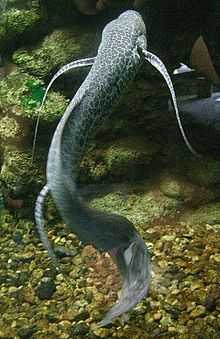Marbled lungfish
| Marbled lungfish | |
|---|---|
 | |
| Scientific classification | |
| Kingdom: | Animalia |
| Phylum: | Chordata |
| Subphylum: | Vertebrata |
| Class: | Sarcopterygii |
| Subclass: | Dipnoi |
| Order: | Lepidosireniformes |
| Family: | Protopteridae |
| Genus: | Protopterus |
| Species: | P. aethiopicus |
| Binomial name | |
| Protopterus aethiopicus Heckel, 1851[1] | |
| Subspecies | |
The marbled lungfish (Protopterus aethiopicus) is a lungfish of the family Protopteridae. Also known as the leopard lungfish, it is found in Africa. At 133 billion base pairs[2] it has the largest known genome of any vertebrate and one of the largest of any organism on Earth, along with Polychaos dubium and Paris japonica at 670 billion and 150 billion, respectively.
Description
The marbled lungfish is smooth, elongated, and cylindrical with deeply embedded scales. The tail is very long and has tapers at the end. They can reach a length of up to 2 m (6.6 ft).[1] The pectoral and pelvic fins are also very long and thin, almost spaghetti-like, used for gliding through the water. The newly hatched young have branched external gills much like those of newts. After two to three months, the young metamorphose into the adult form, losing their external gills for gill openings. These fish have a yellowish gray or pinkish-toned ground color with dark slate-gray splotches, creating a marbling or leopard effect over their bodies and fins. The color pattern is darker along the top and lighter below.[3]
Distribution
Protopterus aethiopicus is found in the African countries of Tanzania, Ethiopia, the Democratic Republic of Congo, Kenya, Uganda, and the Sudan. Specifically, it lives in the Nile River and in lakes such as Albert, Edward, Tanganyika, Victoria, Nabugabo, No, and Kyoga.[4]
References
- ↑ 1.0 1.1 Fishbase.org
- ↑ IJ Leitch (13 June 2007). "Genome sizes through the ages". Heredity (Nature Publishing Group) 99 (2): 121–122. doi:10.1038/sj.hdy.6800981. ISSN 0018-067X.
- ↑ Animal-world.com
- ↑ Fishbase.org